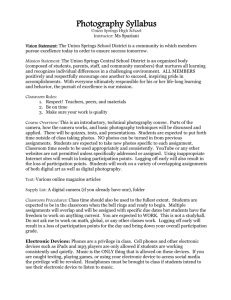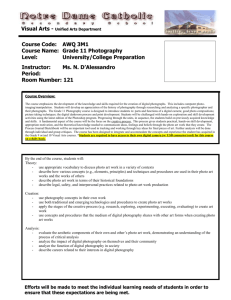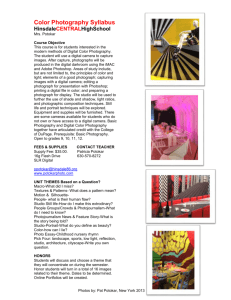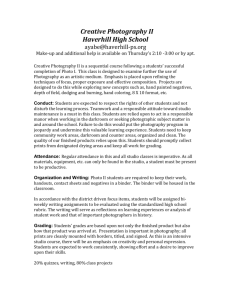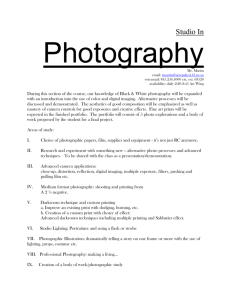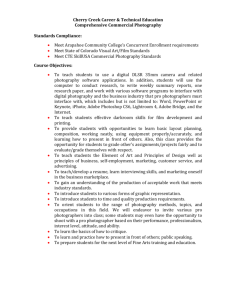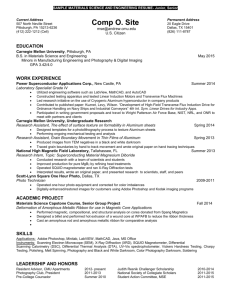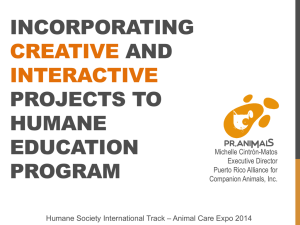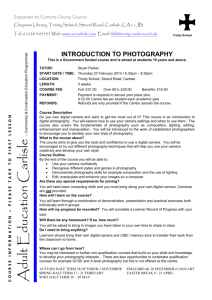Course Name: Grade 12 Photography
advertisement
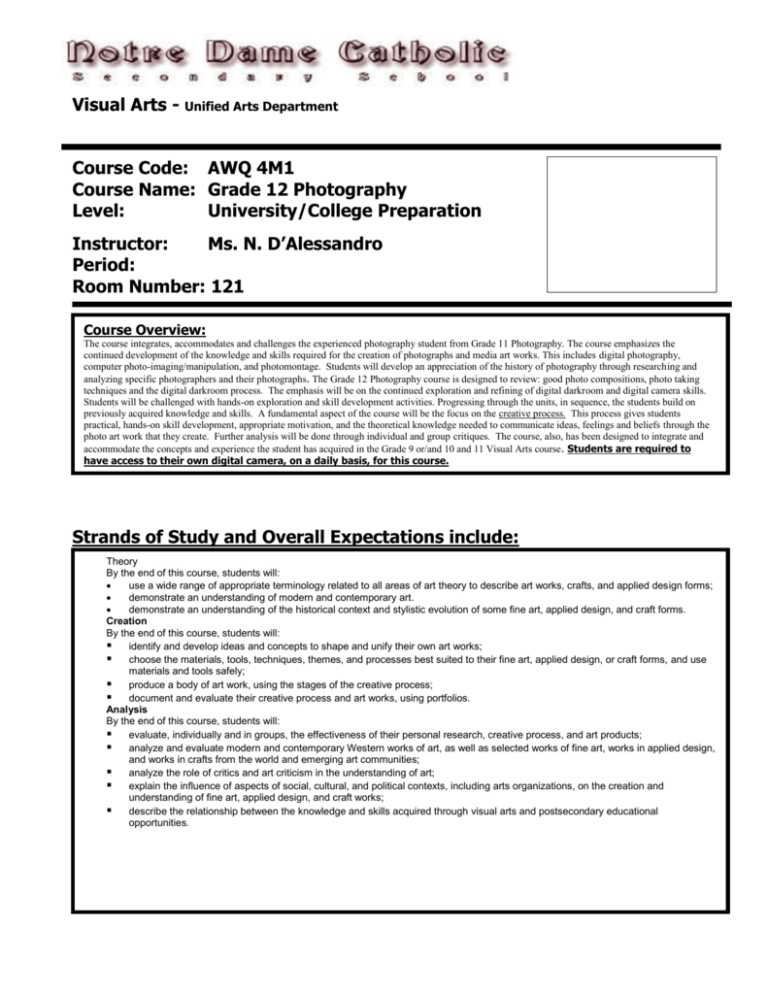
Visual Arts - Unified Arts Department Course Code: AWQ 4M1 Course Name: Grade 12 Photography Level: University/College Preparation Instructor: Ms. N. D’Alessandro Period: Room Number: 121 Course Overview: The course integrates, accommodates and challenges the experienced photography student from Grade 11 Photography. The course emphasizes the continued development of the knowledge and skills required for the creation of photographs and media art works. This includes digital photography, computer photo-imaging/manipulation, and photomontage. Students will develop an appreciation of the history of photography through researching and analyzing specific photographers and their photographs. The Grade 12 Photography course is designed to review: good photo compositions, photo taking techniques and the digital darkroom process. The emphasis will be on the continued exploration and refining of digital darkroom and digital camera skills. Students will be challenged with hands-on exploration and skill development activities. Progressing through the units, in sequence, the students build on previously acquired knowledge and skills. A fundamental aspect of the course will be the focus on the creative process. This process gives students practical, hands-on skill development, appropriate motivation, and the theoretical knowledge needed to communicate ideas, feelings and beliefs through the photo art work that they create. Further analysis will be done through individual and group critiques. The course, also, has been designed to integrate and accommodate the concepts and experience the student has acquired in the Grade 9 or/and 10 and 11 Visual Arts course. Students are required to have access to their own digital camera, on a daily basis, for this course. Strands of Study and Overall Expectations include: Theory By the end of this course, students will: use a wide range of appropriate terminology related to all areas of art theory to describe art works, crafts, and applied design forms; demonstrate an understanding of modern and contemporary art. demonstrate an understanding of the historical context and stylistic evolution of some fine art, applied design, and craft forms. Creation By the end of this course, students will: identify and develop ideas and concepts to shape and unify their own art works; choose the materials, tools, techniques, themes, and processes best suited to their fine art, applied design, or craft forms, and use materials and tools safely; produce a body of art work, using the stages of the creative process; document and evaluate their creative process and art works, using portfolios. Analysis By the end of this course, students will: evaluate, individually and in groups, the effectiveness of their personal research, creative process, and art products; analyze and evaluate modern and contemporary Western works of art, as well as selected works of fine art, works in applied design, and works in crafts from the world and emerging art communities; analyze the role of critics and art criticism in the understanding of art; explain the influence of aspects of social, cultural, and political contexts, including arts organizations, on the creation and understanding of fine art, applied design, and craft works; describe the relationship between the knowledge and skills acquired through visual arts and postsecondary educational opportunities. EffortsBreakdown will be made to meet the individual learning needs of students in order Resources: Course to ensure these expectations are being met. Unit 1: Review of the Camera/Creative Process Journal Elements and Principles in Photography Design Assignment Back into the Digital Darkroom: Photomontage Unit 2: A Focus on Light Portraiture/Still-Life Portrait Photographers We Love Advanced Scan-o-gram Unit 3: Camera/Computer Techniques Movement, Detail, Experimental Unit 4: Interpretative Series Piece Fabricated Reality The course will use a variety of resources including video, CD-ROM, Internet Applications and a variety of print sources. The textbook Discovering Art History will be distributed to students during the first week of the course. The text and all other resources assigned to students are the responsibility of the student. Any damage incurred will result in payment for replacement. Replacement cost for the text is $70.00. Evaluation Structure:: Unit 5: Photographic Essay Series This unit is the Culminating Task and must be completed within class hours. Because of the nature of culminating tasks, late work will not be accepted. Culminating Task: Dec.14 to Jan. 18. Compensation for any missed classes will only be granted if a medical note is provided. Knowledge/Understanding Thinking/Inquiry Communication Application 20% 20% 20% 40% The above is reflected both in the term work (worth 70% of the final mark) and the summative work (worth 30% of the final mark). The final exam will be a presentation exam during the exam week. Evaluation Policy Students will be assessed & evaluated according to the work produced & skills displayed. Methods of providing feedback will include assessing work in process & evaluating completed assignments, tests, co-operative learning activities, simulations and presentations. Peer & self-evaluations will also be utilized. Student marks will be determined by evaluating process & product according to 4 categories & 4 levels. Please see the chart below for specific skills and key words used to determine student competency in the different categories. Level Category Level 1: 50-59% Knowledge/Understanding -Limited display of knowledge, Thinking/Inquiry skills and Critical thinking skills Creative thinking skills ability to The students Inquiry will Skills be working on their Culminating Task from Dec 21 to Jan apply Communication Attendance is critical during this process. If a student is concepts to ill to come to Knowledge of facts & terms Understanding of concepts & relationships school, Communication of ideas information a medical note wouldand enable us to provide Use of symbols & visuals Oral & written communication Level 2: 60-69% -Some success in displaying knowledge, skills and 24 application of concepts accommodations. Level 3: 70-79% Level 4: 80-100% -Considerable display of knowledge skills and ability to apply concepts -Thorough +understandin g of concepts and ability to communicate, think creatively and apply concepts Application Applications in familiar contexts Transfer of concepts to new contexts Making logical conclusions and predictions Use of technology Making connections Feedback will also be provided for student learning skills. Skills like working independently, collaboration, organization, responsibility, self-regulation, and initiative are assessed independently student achievement and will be conducted through the use of a rubric indicating specific criteria to be achieved to receive each of the following letter grades: E –Excellent G – Good S – Satisfactory N - Needs Improvement Other Evaluation Issues LATE ASSIGNMENTS. Assignments submitted after the Primary Due Date established by the teacher will be accepted with a penalty of 10% This three day Penalty Zone is the maximum time allowed for submissions. The third day after the assignment is due is considered the Closure Date upon which no further assignments will be accepted. Repeated lateness in submissions indicates poor organization skills and will result in parental contact and will be reflected in the learning skills section of the report card. INCOMPLETE ASSSIGNMENTS Assignments will be graded according to the extent with which they meet the criteria established in the rubric or evaluation structure. MISSED TESTS Tests missed with a legitimate reason will be written within a few days of the student returning from the absence. Student eligibility to write the test and the date of writing will be at the discretion of the teacher in consultation with the department head. CULMINATING ACTIVITIES These activities will be due toward the end of the course. They are valued 30 per cent of the final mark and will reflect course material and competencies. Plagiarism in any form reflects academic dishonesty and will result in a mark of zero for the assignment in


